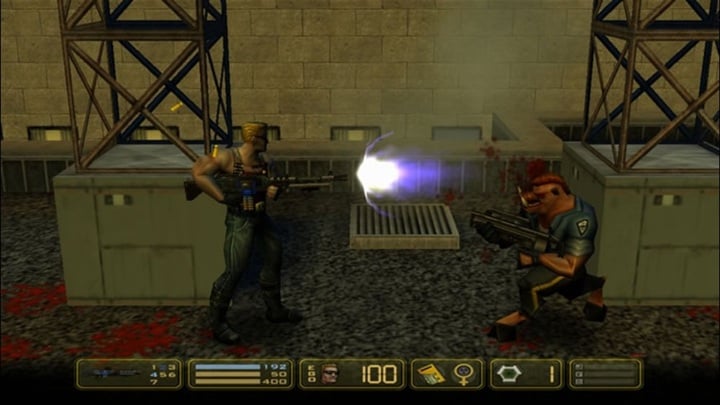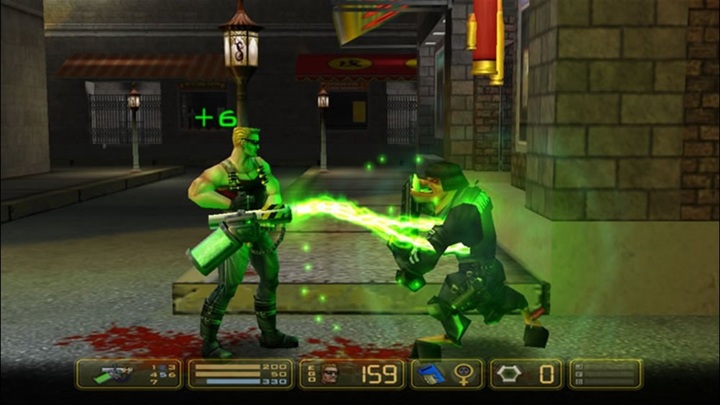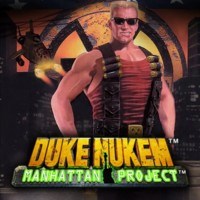A side-step ahead of Duke Nukem Forever. Manhattan Project was a great spin-off of Duke's adventures
In anticipation of Duke Nukem Forever, fans of the franchise received a spin-off of the series. Duke Nukem: Manhattan Project was a good game, so to speak, returning to the roots of the series.

The year 2002 is exceptionally important to me. In the second half of August, I finally got my first computer (for "learning", of course!), which was going to have a big impact on my whole future life. Around January, I started seriously preparing to hit the keys of my own keyboard for the first time, avidly reading magazines from that era, gradually awakening a love for video games.
In early spring, I got the first bits of information about the legendary Duke Nukem Forever, which was supposed to be the best game in the world. Even though it was still in development, it was already clear that it would outshine everything that came before and after it. Imagine my surprise when, just a few weeks later, I was able to read a review of another Duke Nukem, and shortly after, play it on a friend's computer (and, in the longer term, also on my own)! Well, it wasn't the same production, but hey, if DNF is supposed to be the messiah of video games, then its adventure in Manhattan had to be at least amazing, right?
And so my sentiment for Duke Nukem: Manhattan Project was born. Even though it's been 23 years since those events (hard to believe!), my mind still perceives this game through the prism of personal memories associated with discovering the "new, fascinating world" that the entire video game industry was for me at that time. So, how it really was? Let's check what Duke had to do during his time in Manhattan.
Back to the roots... but not quite
In 2002, many players knew about Duke Nukem primarily from Duke Nukem 3D, a classic first-person shooter. Meanwhile, the first game about Duke was an action platformer, which is why Duke Nukem: Manhattan Project could be seen as a return to the roots. At the time of this game's release, not everyone was pleased with this change (especially those who were eagerly awaiting Duke Nukem Forever). However, I liked this approach very much. The reason was really simple - as a beginner computer player, raised on Pegasus, and therefore, Contra, Robocop, and other "shooters" - I felt right at home in sidescrolling games like Duke Nukem: Manhattan Project.
Roughly speaking, because the production we're talking about had 3D graphics and the camera often changed positions, showing the action from different angles, not just from the side. What for me looked almost "like a movie," for battle-hardened "pros" was just a nice visual setting. A young player, like the early me, might also like the title due to its high level of brutality. Sure, you could turn it off by disabling the "Slaughter" option in the settings, but who would actually do that? I mean, we've seen crazier stuff in games like Carmageddon.

Well-known and liked mechanic
The devs didn't try to reinvent the wheel in Duke Nukem: Manhattan Project, so they relied on proven mechanics. The titular muscle guy was running around Manhattan, jumping on platforms, avoiding traps and obstacles, and fighting enemies. The protagonist was given access to an arsenal that included both classic guns and more inventive firearms. He had a revolver, shotgun, machine gun, and grenade launcher in his arsenal.
Duke was primarily fighting mutated animals like pigs, alligators, and cockroaches. The main character also had my favorite X-3000 cannon at his disposal, which shoots a ray that restores enemies to their original form, basically turning them into defenseless creatures vulnerable to kicks, for example. Besides that, Duke also had to deal with other enemies, including the leading Fem-Mechs, which were androids equipped with whips and had the appearance of women.
This is not the end, because Duke could also use a jetpack, which allowed him to lift off the ground and reach high-altitude (and usually hard-to-reach) places.

Duke to the rescue
Our main goal in Duke Nukem: Manhattan Project was to defeat Mech Morphix, who was experimenting with a radioactive substance and creating the aforementioned mutants to take over New York with their help. Following his trail, Duke traversed not only through the rooftops of skyscrapers, but also canals and subways, an industrial complex, a tanker, a drilling tower, and even a space station. The game was divided into levels, and at the end of each level, Duke had to defeat a boss to rescue a trapped woman.
The gameplay was diversified by occasional (and very simple, but still) environmental puzzles. Also, there was a little room for character development system, because after collecting 10 power-ups called "Nukes" we could increase the durability of our boy. The developers also had an interesting idea for resolving the issue of the main character's "life." As you may know, in the Uncharted series, Nathan Drake would die from the first accurate shot, after using up all his "luck."
However, when Duke was getting hit, it was not his body that suffered, but his... EGO. Another thing is that it was at least as big as he was, which he made clear by not shying away from his sarcastic remarks, which were his trademark.

What happened next and how to play Duke Nukem: Manhattan Project today?
Duke Nukem: Manhattan Project received quite a warm reception from players and reviewers. Unfortunately, the game never got a sequel. To make matters worse, at the moment of writing these words, the game is nowhere to be found on both Steam and GOG.com. A second-hand boxed edition of the game costs at least 7 bucks.
Fortunately, in 2010, the described title also hit the Xbox 360 and today it can be purchased in the Microsoft Store for $9.99. The game is compatible with Xbox One and Series X/S.
0

Author: Christian Pieniazek
Started working with Gamepressure.com in August 2016. Although the Game Encyclopedia has been his pride and joy from the beginning, he also writes for the Newsroom and the Editorial section. Gained professional experience through a now-defunct service, in which he worked for almost three years. Graduated in Cultural Studies at the AGH University of Krakow. Runs his own business, jogs, cycles, loves mountain hiking, is a fan of nu metal, is interested in space, and of course, enjoys playing games. Feels best in action games with an open world and RPGs, although won't turn down good racing or shooting games.
Latest News
- Steam has revealed the biggest winners of 2025. Game of the Year didn't make the list
- Clair Obscur players see „inspiration” from Game of the Year 2025 in a new title from China, much to the annoyance of jRPG fans
- Dark Souls creator doesn't consider himself the father of the new action RPG genre
- 3 games to claim on Amazon Prime Gaming, including a cyberpunk RPG from the iconic series
- Discovery in RDR2 after 7 Years. Mysterious phenomenon appears only at night


